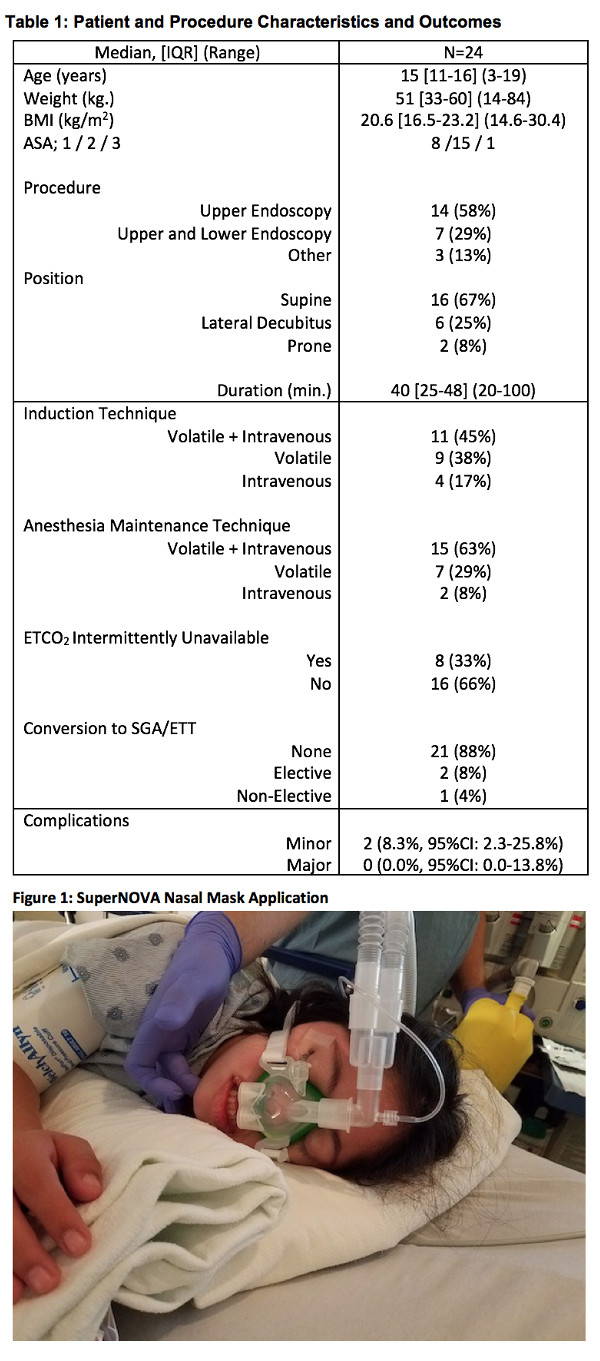NM-316
An Evaluation of the SuperNO2VA Nasal Mask as an Alternate Airway for Short General Anesthetics
Rao S, Tantoco A, Hajduk J, Jagannathan N
Ann & Robert H. Lurie Children's Hospital of Chicago, Chicago, IL, USA
Introduction
Esogastroduodenoscopies (EGDs) are often performed under general anesthesia (GA) in children. Oxygenation options include endotracheal tube (ETT), supraglottic airway (SGA) or nasal cannula (NC). Primary anesthetic concerns include achieving adequate depth of anesthesia while avoiding respiratory complications, which are reported high as 1.5% (1-3). The SuperNO2VATM (SuperNOVA) nasal mask creates a seal around the nose and allows for attachment to a supplemental oxygen source or anesthesia circuit, as well as delivery of PEEP, ventilatory support, and nasal ventilation with positive pressure. The aim of this pilot study was to assess our clinical use of the SuperNOVA as an airway device in children.
Methods
After IRB approval, medical records of patients where the SuperNOVA was used as an alternative to ETT or NC were reviewed. Patient demographic, procedural data, and respiratory complications classified as minor (coughing, desaturation <90%, reversible airway obstruction) or major (laryngospasm, bronchospasm, aspiration), and conversion to SGA/ETT were abstracted. The primary outcome was the frequency of complications.
Results
Twenty-four patients, with a median age 15 yrs (IQR: 11-16) underwent general anesthetic procedures with use of the SuperNOVA, primarily for upper (58%) and combined upper with lower endoscopies (29%) for a median procedure time of 40 minutes (IQR: 25-48), under combined volatile and intravenous anesthesia (63%). Two patients (4.2%, 95%CI: 0.7-20.2%) had minor complications consisting of 1) coughing/airway reactivity intraoperatively and 2) a desaturation to 90% resulting in one non-elective conversion to SGA. There were no major complications (0%, 95%CI: 0.0-13.8%)
Discussion
The main finding of this pilot analysis is that the Supernova provides effective oxygenation, with a low incidence of complications for brief procedures in children. Advantages of using this device vs. NC include the potential for higher FIO2 delivery, ability to augment anesthetic depth via inhaled agents, and provides rescue ventilation in the case of hypoventilation/ desaturations. When compared to tracheal intubation, this technique is less invasive, potentially contributing to faster patient recovery and turnover time. Further larger studies are needed to fully characterize SuperNova use in children.
Conclusions
We demonstrate the SuperNOVA provides effective oxygenation in children, and may be an alternative to ETT and NC for brief procedures
1. Patino M. Comparison of different anesthesia techniques during esophagogastroduedenoscopy in children: a randomized trial. Paediatr Anaesth. 2015; 25: 1013-1019.
2. Friedt M. An update on pediatric endoscopy. Eur J Med Res. 2013; 18: 24.
3. Dar AQ. Anesthesia and sedation in pediatric gastrointestinal endoscopic procedures: a review. World J Gastro Endosc. 2010; 2: 257-262.
Top












